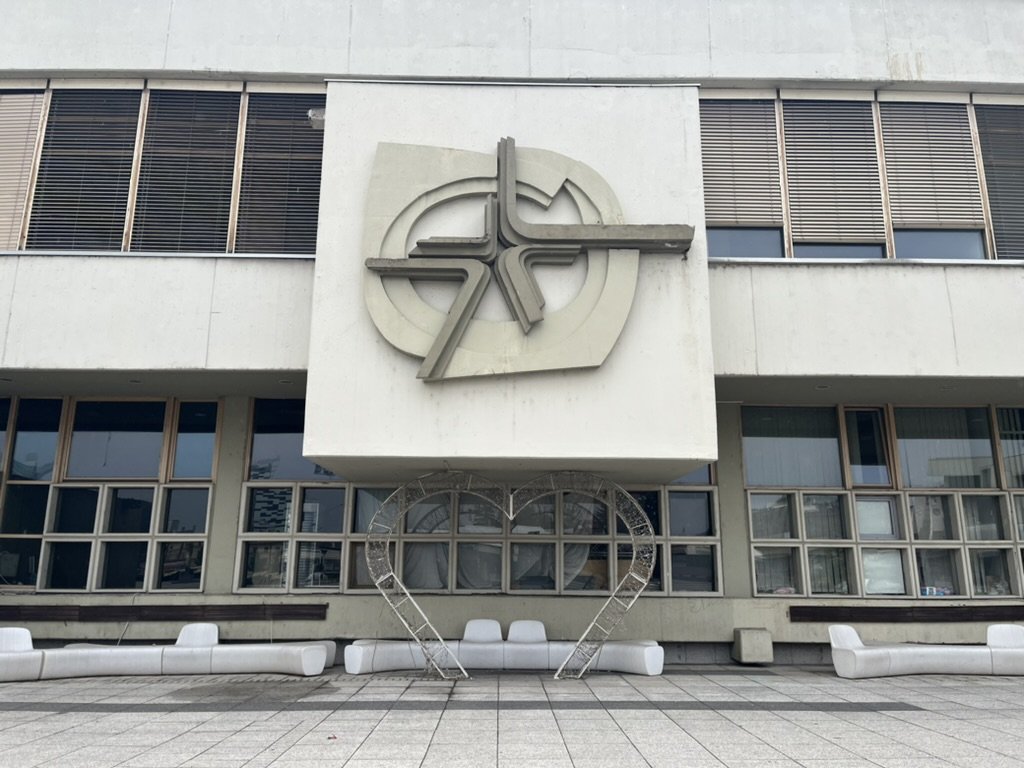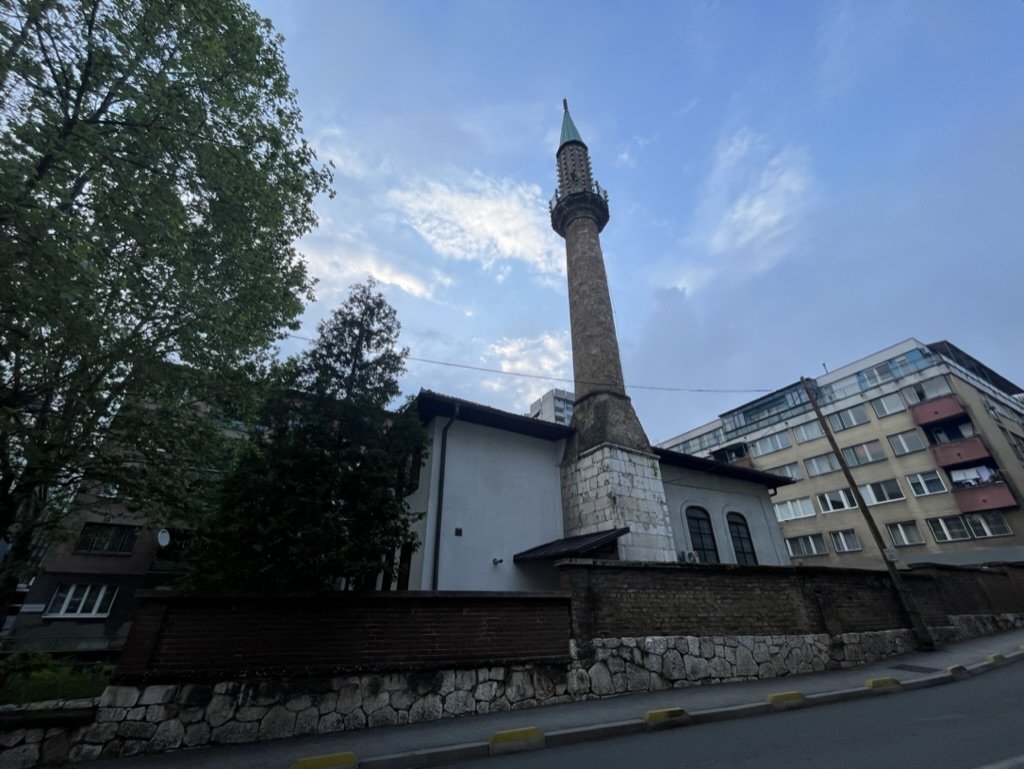SKENDERIJA
© John Bills
In the city centre, the left bank of the Miljacka is dominated by Skenderija, a neighbourhood synonymous with its eponymous sports and cultural centre. The Skenderija Centre was considered a triumph of Yugoslav architecture, but it has seen better days. The neighbourhood itself is an integral cog in city centre life, with its range of architecture and functions.
Skenderija is named after Skender-pasha, a 15th-century man of action who helped develop it through the usual building of shops, markets and caravanserai. Much of that history is now lost, but there is a residential quality to Skenderija that keeps it fresh in an increasingly touristic centre. Also, if you want to learn the Bosnian language, the Bosnian2Go language school is based here, and those guys are excellent.
WHAT TO SEE AND DO
© Pfeiffer // Shutterstock.com
Ashkenazi Synagogue
A location next to the universally derided Papagay building doesn’t hurt, but Sarajevo’s Ashkenazi Synagogue would be a darling no matter its spot. Constructed in 1902, the still-functioning synagogue is another Sarajevo stunner from the catalogue of Czech architect Karel Pařík, and it is even more impressive inside. The intricate decorations of the main room are spellbinding. Hamdije Kreševljakovića 59, +387 33 229 666
© John Bills
Skenderija Centre
Sarajevo’s Skenderija Centre has seen better days, but it isn’t difficult to imagine those glory years when standing in its presence. The centre was opened in 1969 and quickly became the cultural heart of the city, hosting stars before they were famous and providing all the shopping a young Yugoslav could want. It came to the fore during the 1984 Winter Olympics when it starred as a media centre, but the ‘90s war was the death knell for it. It was bombed, burned out, and buggered. It has been somewhat fixed up and occasionally shows signs of life, but this is a place of memories past and not modern memories made. Both the Serb and Croat nationalist parties in BiH had their opening convocations here, which feels somewhat ironic. Terezija bb, +387 33 211 016
© John Bills
Čobanija Mosque
A little cutie of a mosque, Čobanija Mosque is another 16th-century pearler in the centre of Sarajevo. The mosque is named after Čoban-Hasan, the man who financed its construction, but we don’t really know a whole lot about him. Was he the son of a shepherd who resisted gold for this mosque to be built? Was he a duke, a warrior, or a leader? Maybe he was just a rich dude who wanted some fame? Only history knows, but the Čobanija Mosque ploughs its pretty furrow all the same. The stone minaret is one of the city’s finest. Čobanija
© Anze Furlan // Shutterstock.com
Academy of Fine Arts
One of Sarajevo’s most striking buildings, the Academy of Fine Arts was established in 1972 at the behest of Sarajevo’s artistic community. The gallery hosts exhibitions from students and professors throughout the year, but it is difficult to look past the architecture as the show's star. The building started life as an evangelist church designed by (yes, you guessed it) Karel Pařík, but the diminishing evangelist community rendered it locked in limbo by the time Yugoslavia was here. In 1981, it became the Academy of Fine Arts, and it is a fitting setting for artistic development. I don’t like the bridge in front, but then, I am hardly a lightning rod for aesthetic judgment. Obala Maka Dizdara 3, +387 33 210 369
Museum of Optical Illusions
Fun for all the family, as the world is turned upside-down through a series of clever illusions. The Museum of Optical Illusions has fast become one of Sarajevo’s more popular museums, which maybe shows how much we enjoy our perception being messed with. Take a look, take some wacky photos, and then return to normality. Skenderija 28, +387 33 878 000
© John Bills
Fire Brigade Barracks
Almost every town in Bosnia and Herzegovina seems to have been ravaged by a massive fire at some point in its history, and Sarajevo is no different. It wasn’t until 1879 that a volunteer fire brigade was established, and five years later, this building in Skenderija was set aside for staff accommodation. It was expanded over the decades but neglected all the same, although that is the story of firefighting worldwide. The building is blocky but charming, sort of like most firefighters. Fehima efendije Čurčića 1, +387 33 257 330
© John Bills
Ex-Yu Rock Centre
A new development in Skenderija, the Ex-Yu Rock Centre is a big love letter to the glory years of Yugoslav rock music. This place is a treasure trove of memorabilia, with many artefacts, photographs, audio and video exhibits that tell the story of rock music in Sarajevo. The catalogue is growing all the time, once again proving that rock and roll will never, ever die. Terezija, +387 62 332 770
© Yulia Kupeli // Shutterstock.com
Papagajka
In a city that isn’t short on ugly buildings, it takes something extraordinary to be considered the ugliest. That is harsh on the Papagajka (Parrot) building, but this yellow and green structure doesn’t seem to have many supporters on the streets of Sarajevo. I’m a fan, of course, and the building is a warren of curiosities and detailed street art. There are some decent cafes on the ground floor as well. I always wanted to live here, so here’s hoping that comes true before all is said and done. The building was designed by Dragan Bijedić and Mladen Gvozden and completed in 1990 and is an ambitious bridging of architectural ideas and concepts. The colours are vibrant, to say the least, and the staircases are impressive. A position next to the sophisticated Ashkenazi Synagogue only accentuates its uniqueness. Hamdije Kreševljakovića
BREWS, BOOZE AND BITES
© John Bills
A neighbourhood of nooks and crannies, Skenderija doesn’t disappoint on the cafe front. Kutcha (Skenderija 15, +387 62 497 490) is a concept store and bar with a fairytale garden, while Meeting Point (Hamdije Kreševljakovića 13, +387 33 668 186) has been a, erm, meeting point for folks since its opening day. Coffee Station (Skenderija 5a, +387 60 33 32 426) and Freaky’s Pub (Hamdije Kreševljakovića 8, +387 61 209 124) are two decent options next door to each other. Linea M (Obala Mak Dizdara 7, +387 61 555 299) is also great, with some fascinating vintage decor. There are a couple of cafes in and around the Skenderija Centre itself, although nothing of particular interest unless you are into casinos and strip clubs. Elsewhere, Konoba Luka (Obala Mak Dizdara 8, +387 33 209 303) is an excellent restaurant serving Mediterranean fare, Galija (Čobanija 20, +387 33 443 350) is a decent pizzeria and Burger Bar (Skenderija 31b, +387 33 206 055) serves burgers in a bar. The street leading to Ćobanija Bridge is packed with fast food stops (and sushi, if you’re into that).
SLEEPING
© John Bills
There are some excellent sleeping options in Skenderija, and its central location makes it an attractive accommodation choice for visitors of all shapes, sizes and situations. There is a Marriott (Skenderija 1, +387 33 954 500), which is good news if you can afford such things, while Residence Inn (Skenderija 43, +387 33 563 600), Hostel City Rest (Ejuba Ademovića 6, +387 33 444 111) and Aparthotel Center (Muamera Omerbegovića 3, +387 61 484 493) are also tippy-top..









